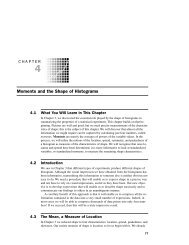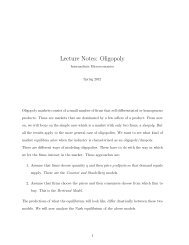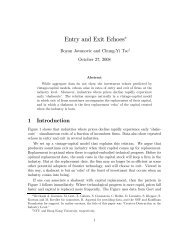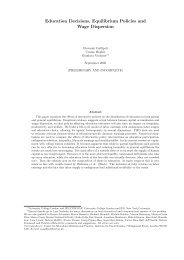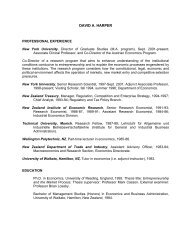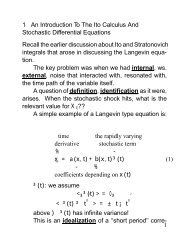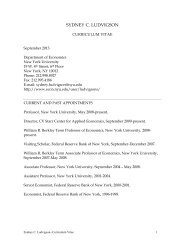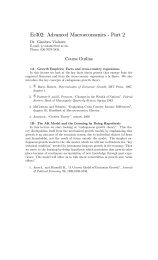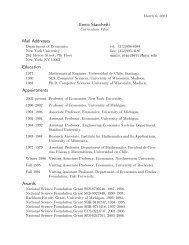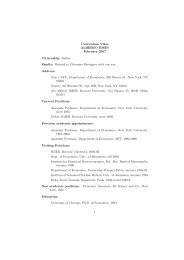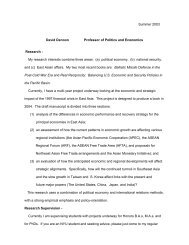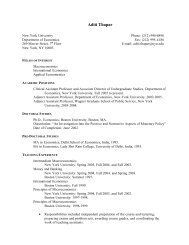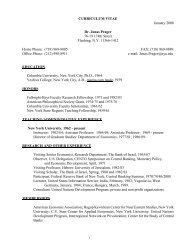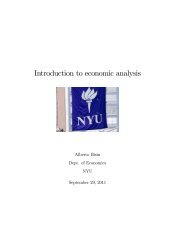On Spatial Processes and Asymptotic Inference under Near$Epoch ...
On Spatial Processes and Asymptotic Inference under Near$Epoch ...
On Spatial Processes and Asymptotic Inference under Near$Epoch ...
Create successful ePaper yourself
Turn your PDF publications into a flip-book with our unique Google optimized e-Paper software.
3.3 Cli¤-Ord Type <strong>Spatial</strong> <strong>Processes</strong><br />
Consider the following Cli¤-Ord type model:<br />
Yn = WnYn + Xn + un (9)<br />
un = Mnun + vn<br />
where Yn = (Y1;n; :::; Yn;n) 0 is an n 1 vector of endogenous variables, Xn =<br />
(Xij;n) is n k matrix of regressors, Wn = (wij;n) <strong>and</strong> Mn = (mij;n) are n n<br />
nonstochastic weight matrices, vn = (v1;n; : : : ; vn;n) 0 is an n 1 vector of disturbances,<br />
<strong>and</strong> are scalar parameters typically referred to as spatial autoregressive<br />
parameters, <strong>and</strong> is a k 1 parameter vector. To simplify presentation, we<br />
assume in the following that k = 1 <strong>and</strong> use the notation Xn = (X1;n; :::; Xn;n) 0 .<br />
The above model is frequently referred to as a spatial ARAR(1,1) model, <strong>and</strong><br />
WnYn <strong>and</strong> Mnun are referred to as spatial lags. For recent contributions on<br />
estimation strategies for this model see, e.g., Robinson (2009, 2007), Kelejian<br />
<strong>and</strong> Prucha (2007a,b, 2004), <strong>and</strong> Lee (2007a,b, 2004).<br />
The spatial weights mij;n <strong>and</strong> wij;n are typically thought of as to depend<br />
on some measure of distance, say dij, between units i <strong>and</strong> j, where the weights<br />
decline as the distance increases. Thus although in Cli¤-Ord models observations<br />
are indexed by natural numbers, i.e., i = 1; : : : ; n, a leading case would<br />
be where i correspond to some location, say si 2 R d , <strong>and</strong> the distance between<br />
i <strong>and</strong> j is given by dij = (si; sj). In the following, we assume that<br />
Dn = fs1; : : : ; sng D, where the lattice D satis…es Assumption 1. However,<br />
to simplify notation we will use (i; j) instead of (si; sj). We assume<br />
furthermore that for all n<br />
In Wn <strong>and</strong> In Mn are nonsingular. (10)<br />
The reduced form of the model is then given by Yn = AnXn + Bnvn:with<br />
An = (aij;n) = (In Wn) 1 <strong>and</strong> Bn = (bij;n) = (In Wn) 1 (In Mn) 1 .<br />
In scalar notation we have for i = 1; :::; n:<br />
Yi;n =<br />
nX<br />
j=1<br />
aij;nXj;n +<br />
nX<br />
j=1<br />
bij;nvj;n;<br />
Although for …xed n; the output process Yi;n depends on only a …nite number of<br />
elements of the input process "i;n = (Xi;n; vi;n) 0 , the mixing property of "i;n may<br />
not carry over to Yi;n: The reason is that the number of elements composing the<br />
spatial lags grows unboundedly with the sample size so that the mixing property<br />
can break down in the limit. This is especially important when analyzing the<br />
asymptotic properties of Cli¤-Ord type processes.<br />
Towards establishing that Y = fYi;n; si 2 Dn; n 1g is NED on " =<br />
f"i;n; si 2 Dn; n 1g, we maintain the following assumptions:<br />
lim<br />
s!1 sup sup<br />
n<br />
X<br />
jaij;nj + jbij;nj = 0 (11)<br />
1 i n<br />
1 j n: (i;j)>s<br />
8



